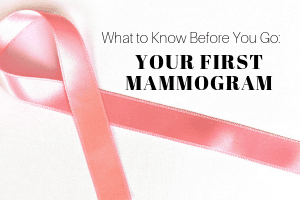Moms are BUSY. And we often push self-care to the very end of the mile long (and growing) to-do list.
But as a breast oncologist and mom, I urge you to push your yearly mammogram back to the top. You should start having mammograms annually at age 40, and for some high-risk women, even earlier.
In 2018, it is estimated that there will be over 266,120 new cases of invasive breast cancer. The good news is breast cancer found in its earliest stages—before we can even feel it on self-exam—is very curable. Annual mammograms have helped lower the risk of death from breast cancer. Yearly mammograms are your best defense against breast cancer. They allow us to detect breast cancer early when it is most treatable.
When Should You Get a Mammogram?
If you are at average risk, you should get a mammogram every year starting at age 40. If you are at high-risk, you may be encouraged to get a yearly breast MRI as early as age 25 and a mammogram at 30. Talk to your doctor to determine your individual risk factors and screening schedule.
Who’s at High-Risk?
You may be high-risk for breast cancer if you have:
- A mutation of the BRCA1 or BRCA2 genes
- Personal history of breast cancer
- A family member diagnosed before age 50
- Multiple family members with breast cancer
- Dense breasts (as determined by a mammogram)
- Previous breast exposure to radiation therapy before age 30 (like with Hodgkin’s lymphoma treatment)
- Pregnancy after age 30 or no children
- Did not breastfeed
- Obesity, particularly after menopause
- First period before age 13
- Menopause after age 51
- Prolonged hormone replacement therapy
- Previous biopsy results that indicate atypical hyperplasia, lobular carcinoma in situ, or radial scar formation
Take a Free Online Breast Cancer Risk Assessment
Your Top Mammogram Questions
What should you wear?
You will want to dress for comfort. Depending on the type of mammogram, you may only need to remove your top. We typically ask that you don’t wear deodorant, perfume or powder. If you forget, the staff can give you wipes to remove excess from your skin.
What will it be like?
You will stand in front of the mammography unit, a technologist will uncover your breast and position it on a clear plastic plate. Then a second plate will lower and your breast will be pressed between the two plates. It may be a little uncomfortable, but if it starts to hurt, let your technician know so they can make adjustments. Images are then taken of each breast from the front and the side.
If you have your period and your breasts are tender or swollen, you may want to consider rescheduling. Scheduling your mammogram for the week following your period may help ease discomfort.
Can you get a mammogram if you’re pregnant or breastfeeding?
A mammogram is not recommended for pregnant women. If your doctor feels it’s important for you to be screened while pregnant, a breast ultrasound is recommended.
Do not skip your yearly mammogram if you are breastfeeding. It is safe and will not affect the breast milk.
Breastfeeding can make your breasts more tender. Let your technician know you are breastfeeding and if you experience any discomfort. They can make adjustments to help make you more comfortable.
Your breast tissue may appear more dense than usual, making it harder for the radiologist to read the results. Bringing your child with you for a feeding right before the test can reduce the amount of milk in your breasts and result in a clearer image. You may also want to check that your radiologist is aware you are breastfeeding and is experienced in reading mammograms of lactating mothers.
Can you get a mammogram if you have breast implants?
Yes! It’s safe and yearly mammograms are still necessary if you have breast implants. Be sure to let your technologist know. The machine may require special adjustments to allow for the best possible images.
It’s More Convenient than You May Think
This breast cancer awareness month, make a decision to put your health first. For October, many of our eightscreening locations offer Saturday and extended hours. We also offer online scheduling and some of our locations even offer walk-in screening. The mammogram itself will take about 20 minutes.
The Results
You should always receive the results of your mammogram. If the results are normal, we will see you again next year. If there are any abnormalities, your doctor may refer you to a breast specialist or a surgeon for further testing. HCA Midwest Health offers 7 cancer centers, including four nationally accredited Breast Centers to make taking care of your breast health as convenient as possible.
[hr]
 Dr. Stephanie Graff is Director of the Breast Program at the Sarah Cannon Cancer Institute at HCA Midwest Health and Associate Director of the Breast Cancer Research Program at Sarah Cannon Research Institute. She is board certified in Medical Oncology, Hematology and Internal Medicine. Dr. Graff is passionate about connecting with her patients for personalized care, providing comprehensive oncology care, advancing breast cancer research, and breast cancer prevention. In addition to serving as Principal Investigator on numerous clinical trials, she leads the BE AWARE & Breast Cancer Prevention clinics for Sarah Cannon HCA Midwest Health and is a sought-after public speaker. Outside the clinic, Dr. Graff is busy as wife and mother to three children, enjoys reading and fitness, and is active in community service.
Dr. Stephanie Graff is Director of the Breast Program at the Sarah Cannon Cancer Institute at HCA Midwest Health and Associate Director of the Breast Cancer Research Program at Sarah Cannon Research Institute. She is board certified in Medical Oncology, Hematology and Internal Medicine. Dr. Graff is passionate about connecting with her patients for personalized care, providing comprehensive oncology care, advancing breast cancer research, and breast cancer prevention. In addition to serving as Principal Investigator on numerous clinical trials, she leads the BE AWARE & Breast Cancer Prevention clinics for Sarah Cannon HCA Midwest Health and is a sought-after public speaker. Outside the clinic, Dr. Graff is busy as wife and mother to three children, enjoys reading and fitness, and is active in community service.
















